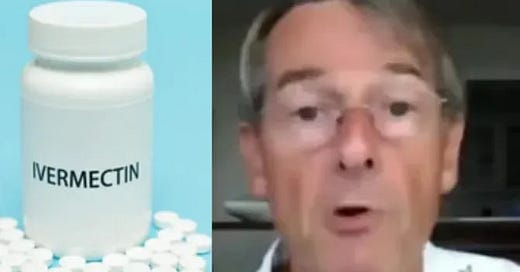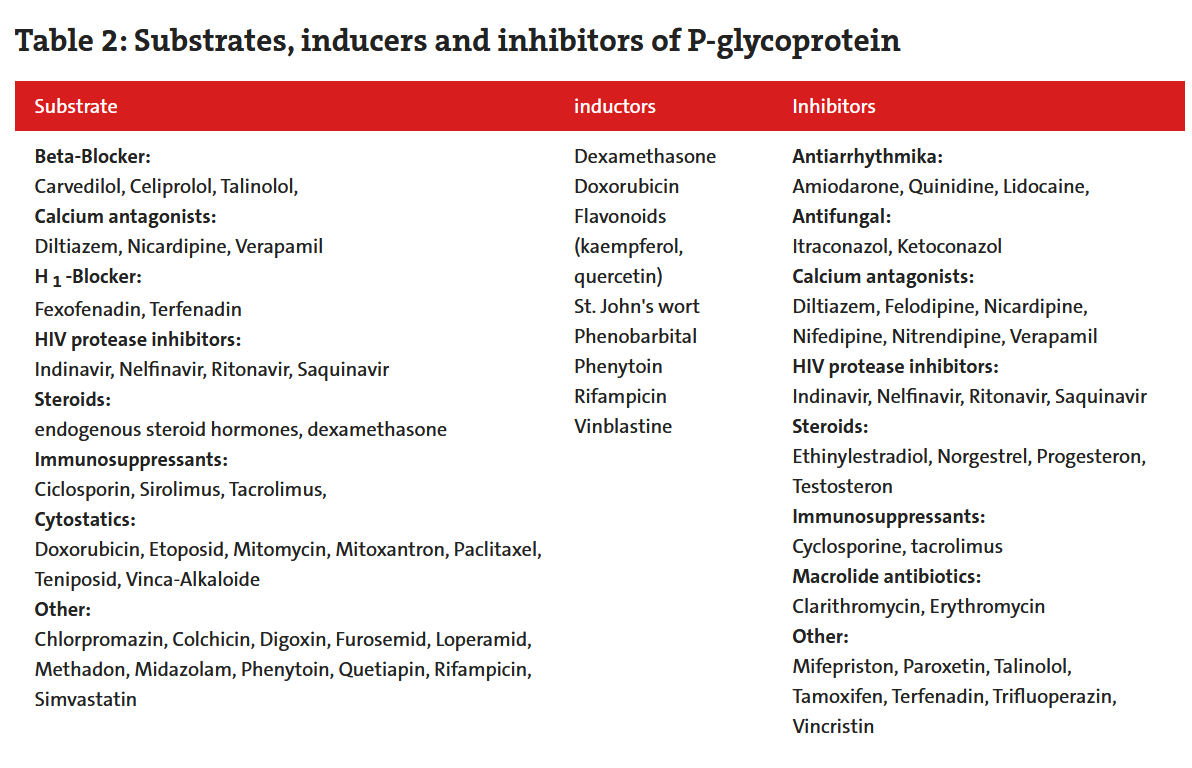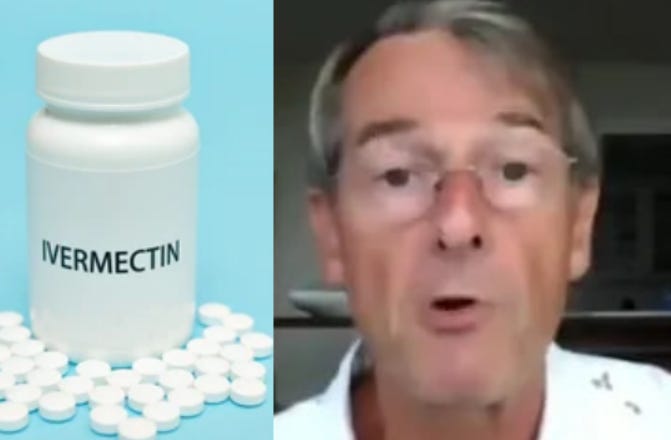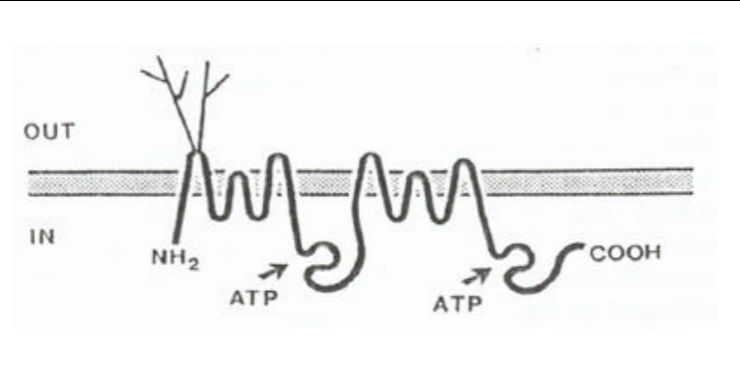Dr. Mike Yeadon against the "Covid" cartel – PART 6 : The P-gp inhibitors: substances that, by inhibiting P-gp (P-glycoprotein / pgp), also inhibit the excretion of ivermectin from the body.
Additional information to the previous article. P-glycoprotein - important for the detoxication of the body. Synonyms : pgp, p-gp, multidrug resistance protein 1, MDR1, PGP, PGP-pump.
Foreword
Dr. Mike Yeadon, December 7, 2024 :
https://t.me/DrMikeYeadonsolochannel/2225
If you’re further interested in the clearance pathways for ivermectin and many other drugs, this background information will be helpful to you. I thank Suavek for sleuthing and assembling some highly relevant information.
Best wishes
Mike
…………………………………………………………………………………………………………………………
The purpose of the article / The introduction
by Suavek
In the previous article on the toxicity of ivermectin, we learned from Dr. Mike Yeadon that people who are prescribed this drug are not informed that certain substances inhibit the effect of the P-glycoproteins. The inhibited effect of the P-glycoproteins then prevents the ivermectin from being excreted from the body in time, so that over time the effect of the ivermectin increases as if you had taken an overdose of the drug.
In this article, I have gathered information about which substances are the ones that inhibit the action of P-glycoproteins, so that the excretion of ivermectin is also inhibited. You can find it below under the heading "Inhibitors".
Disclaimer :
I forward this information from the Internet, but I cannot make any guarantees regarding its accuracy and accept no responsibility for these texts. If I add something of my own, then it is not advice, but merely my personal opinion. The remaining texts also do not constitute medical advice.
The information provided was partly translated into English from German conventional medical websites (unfortunately also from the pharmaceutical industry websites, for which I hereby apologize with a blush on my face). I have not checked for possible errors. It remains to be hoped that we have only translated simple texts here that do not contain much room for errors.
…………………………………………………………………………………………………………………………
P-glycoprotein
March 21, 2024
Authors :
Dr. Farouk J. Khury, Dr. Frank Antwerpes + 8
Synonyms: P-glycoprotein, multidrug resistance protein 1, MDR1
1. Definition
P-glycoprotein , P-gp for short , is a membrane protein that actively pumps foreign substances out of the cell into the extracellular space . It is involved in the development of multidrug resistance .
2. Physiology
The P-glycoprotein is an ABC transporter . It transports ATP while consuming hydrophobic substrates across the lipid membrane back into an outer compartment , i.e. primarily actively. It is the gene product of the ABCB1 gene.
The P-glycoprotein is particularly expressed in the cells of the blood-brain barrier . It is currently assumed that the transporter, like other ABC transporters, plays a major role in the permeability of this structure. For example, the P-glycoprotein is responsible for the fact that loperamide , a synthetic opioid used to treat diarrhea, does not reach the central opioid receptors but only occupies the local receptors in the myenteric plexus .
3. Undesirable effects
Expulsion of cytostatics from tumor cells
Removal of antibiotics from bacteria
Influencing the oral bioavailability of drugs (usually reduction)
4. Drug interactions
Certain medications can be substrates, inhibitors or inducers of P-glycoprotein and thus alter the absorption of substances. [1] [2] Often the substrates are also substrates of CYP3A4 .
The interactions can lead to an increased effect or increased toxicity or to a reduced effect of a drug. Furthermore, inhibitors of the P-glycoprotein can enable the CNS penetration of other substances.
5. Literature
Cozza KL, Armstrong SC, Oesterheld JR. Drug Interaction. Principles for Medical Practice. American Psychiatric Publishing, Inc. 2003, Second Edition
6. Sources
↑ Greiner C. P-glycoprotein - significance for drug metabolism , accessed on November 28, 2019
↑ When drugs influence transport proteins , Pharmazeutische Zeitung, 50/2006, accessed on November 28, 2019
Keywords: glycoprotein , membrane protein , transport protein
Areas of expertise: biochemistry , pharmacology , physiology
Source : https://flexikon.doccheck.com/de/P-Glykoprotein
………………………………………………………………………………………………………………………….
Editor's note:
You can also find some inhibitors in the other articles below.
………………………………………………………………………………………………………………………….
P-glycoprotein
From the Wikipedia
( … )
P-gp transports various substrates across the cell membrane including :
Drugs such as colchicine, desloratadine,[15] tacrolimus and quinidine.
Chemotherapeutic agents such as topoisomerase inhibitors (i.e. etoposide, doxorubicin), microtubule-targeted drugs (i.e. vinblastine), and tyrosine kinase inhibitors (i.e. gefitinib, sunitinib).
Lipids
Steroids
Xenobiotics
Peptides
Bilirubin
Cardiac glycosides like digoxin
Immunosuppressive agents
Glucocorticoids like dexamethasone
HIV-type 1 antiretroviral therapy agents like protease inhibitors and nonnucleoside reverse transcriptase inhibitors
Its ability to transport the above substrates accounts for the many roles of P-gp including:
Regulating the distribution and bioavailability of drugs
- Increased intestinal expression of P-glycoprotein can reduce the absorption of drugs that are substrates for P-glycoprotein. Thus, there is a reduced bioavailability, and therapeutic plasma concentrations are not attained. On the other hand, supratherapeutic plasma concentrations and drug toxicity may result because of decreased P-glycoprotein expression
- Active cellular transport of antineoplastics resulting in multidrug resistance to these drugs
The removal of toxic metabolites and xenobiotics from cells into urine, bile, and the intestinal lumen
The transport of compounds out of the brain across the blood–brain barrier
Digoxin uptake
Prevention of ivermectin and loperamide entry into the central nervous system
The migration of dendritic cells
Protection of hematopoietic stem cells from toxins.[5]
It is inhibited by many drugs, such as amiodarone, azithromycin, captopril, clarithromycin, cyclosporine, piperine, quercetin, quinidine, quinine, reserpine, ritonavir, tariquidar, and verapamil.[16]
( … )
Interactions with other medications
Common pharmacological inhibitors of P-glycoprotein include :
Amiodarone , Clarithromycin , Cyclosporine , Colchicine , Diltiazem , Erythromycin , Felodipine , Ketoconazole , [ 32 ] Lansoprazole , Omeprazole and other Proton pump inhibitor , Nifedipine , Paroxetine , Reserpin , [ 33 ] Saquinavir , [ 32 ] Sertraline , Quinidine , Tamoxifen , Verapamil , [ 34 ] and Duloxetin . [ 35 ] elacridar and CP 100356 are other common ones [ Citation required ] P-gp inhibitors. Zosuquidar and Tariquidar were also developed with this in mind. [ Clarification required ] Finally are Valspodar and Reversan further examples of such active ingredients. ABCB1 is linked to the daily dose of warfarin, the is required to maintain the INR target of 2.5. Patients with the GT or TT genotypes of the 2677G>T SNP require approximately 20% more warfarin daily. [ 36 ]
Common pharmacological inducers of P-glycoprotein include Carbamazepine , Dexamethasone , Doxorubicin , Unphased , Phenobarbital , Phenytoin , Prazosin , Rifampicin , St. John's wort , Tenofovir , Tipranavir , Trazodon and Vinblastin . [ 37 ]
P-glycoprotein substrates are susceptible to changes in pharmacokinetics due to drug interactions with P-gp inhibitors or inducers. Some of these substrates are Colchicine , Cyclosporine , Dabigatran , [ 33 ] Digoxin , Diltiazem , [ 38 ] Fexofenadine , Indinavir , Morphine and Sirolimus . [ 32 ]
( … )
Full article / Source :
…………………………………………………………………………………………………………………………
When drugs affect transport proteins
December 11, 2006 11:26 am
( … )
( … )
If a P-GP substrate and a P-GP inhibitor are given at the same time, increased bioavailability of the P-GP substrate can be expected. P-GP substrates can also influence each other in the sense of competitive antagonism. This has clinical implications particularly for drugs with a narrow therapeutic index, where even moderate increases in plasma concentration cause toxic effects.
Digoxin-quinidine
The long-known interaction between digoxin and quinidine is based on an inhibition of P-GP: in almost all digoxin-treated patients, digoxin clearance is significantly reduced over the course of one to seven days after initiation of quinidine treatment. Digoxin intoxication with cardiac arrhythmias (ventricular premature beats, ventricular flutter and fibrillation, asystole) as well as gastrointestinal and neurotoxic symptoms (dizziness, fatigue, color vision, visual field defects) can occur. Quinidine is an inhibitor of P-GP and thus reduces the renal and biliary clearance of digoxin.
( … )
( … )
Full article in German / Source :
………………………………………………………………………………………………………………………….
P-Glykoprotein ( From : PharmaWiki )
P-glycoprotein (P-gp) is a primarily active efflux transporter that transports its substrates from the cell membrane to the extracellular space. It is located, among other things, in the intestine, liver, blood-brain barrier, placenta and kidney and acts as a transport barrier against foreign substances. On the one hand, P-gp inhibits the absorption of these substances into the organism and sensitive organs and, on the other hand, promotes their excretion. The substrates include numerous active pharmaceutical ingredients whose pharmacokinetics are determined by P-glycoprotein. P-gp inhibitors can increase the bioavailability and distribution of the active ingredients. Conversely, inducers enhance the barrier function of the transporter and the elimination of the drugs.
( ... )
Drug Interactions
There is considerable evidence that P-gp exerts an important influence on the pharmacokinetics of its substrates. are Therefore, drug interactions possible, particularly through inhibition or induction of P-gp.
P-gp inhibitors: Active ingredients that inhibit P-glycoprotein can increase absorption , bioavailability and distribution - for example into the central nervous system. At the same time, elimination is reduced. Furthermore, inhibitors can the resistance of cancer cells to cytostatic drugs . eliminate
Examples : Chinidin , Verapamil , Clarithromycin , Erythromycin , Itraconazol , Mefloquin
P-gp inducers: Conversely, simultaneous administration of P-gp inducers increases the barrier function of P-gp and promotes its elimination.
Examples: Rifampicin , St. John's wort
( ... )
It transports hundreds of predominantly hydrophobic substances with a molecular weight between 330 and 4000 Da. These include, for example (selection):
Antidiarrhoica : Loperamide
Antihelminthika : Ivermectin
Antihistamines : I checked
Antithrombotics : Dabigatran
Beta blockers : Talinolol , Celiprolol
Calcium channel blockers : Diltiazem , Verapamil
Glucocorticoide : Dexamethasone
Herzglykoside : Digoxin
HIV Protease Inhibitor : Indinavir , Ritonavir , Saquinavir
Immunosuppressants : Cyclosporine , tacrolimus
Neuroleptics : Acepromazin
Prokinetics : Domperidone
Setrone : Ondansetron
Statins : Atorvastatin
Cytostatics : Colchicin , Doxorubicin , Etoposid , Methotrexat , Paclitaxel (Taxol), Vinblastin , Vincristin.
( ... )
Full article :
https://www.pharmawiki.ch/wiki/index.php?wiki=P_Glykoprotein
………………………………………………………………………………………………………………………….
This information comes from a general Google search :
I entered the following search query: foods that inhibit P-glycoproteins. Perhaps you can find more information by doing your own search ? :
Also, some phytotherapeutics from traditional Chinese medicinal plants and grapefruit components inhibit P-glycoprotein. The rest of the citrus fruits and some other foods can do this as well.
What is a phytotherapeutic?
When medicines are made from plants or parts of plants , they are called phytotherapeutics. These are clearly differentiated from homeopathic medicines or dietary supplements. Both the one and the other have nothing to do with each other.
…………………………………………………………………………………………………………………………
P-glycoprotein is known to play an important role in the detoxication of the body. An example of such a function can be found here :
To protect against toxins that have already entered the bloodstream, P-glycoprotein is expressed along the endothelium of the blood vessels. This has so far been shown in the brain and testes.
The importance of P-gp for the blood-brain barrier has been shown using mdr1a (-/-) knock-out mice. These mice showed greatly increased toxicity due to high concentrations of various substances. Other studies have described disproportionately high concentrations of the anthracycline doxorubicin in cardiac samples from such mice.
Source : https://epub.ub.uni-greifswald.de/frontdoor/deliver/index/docId/192/file/christiane_karsten.pdf
………………………………………………………………………………………………………………………….
P-glycoprotein
P-glycoprotein (P-gp) is an efflux transport protein from the ABC transporter family. Its overexpression in tumor cells is an important cause of a reduced response to cytostatic drugs, the so-called multidrug resistance (MDR). P-gp is also responsible for many drug interactions.
function
P-glycoprotein (P-gp) is a transmembrane efflux transport protein from the family of so-called ABC transporters ( ATP binding cassette transporter , ABCB1). Efflux transporters such as P-gp play an important role in drug transport in many organs. P-gp actively pumps drugs back into the lumen using energy against a concentration gradient, thereby reducing the absorption of the xenobiotics. The expression of P-gp can have direct effects on the absorption, distribution and elimination of drugs.
pharmacology
The occurrence of P-gp was first described for tumor cells. Tumor cells exhibit P-gp overexpression, which reduces access for cytotoxic drugs. Because tumors can become resistant to various cancer drugs via this mechanism, P-gp is also known as multidrug resistance protein 1 (MDR-1). P-gp is also expressed in various non-tumorous tissues with excretory functions (small intestine, liver and kidney) and at blood-tissue barriers (blood-brain barrier, blood-testis barrier and placenta).
In addition to the cytochrome P450 (CYP) family, the expression of P-gp is also considered an important evolutionary adaptation against potentially toxic substances.
( ... )
Full article :
https://www.gelbe-liste.de/arzneimitteltherapiesicherheit/p-glycoprotein
………………………………………………………………………………………………………………………….
There is no information about PGP here, but the article still seems interesting, especially the part about grapefruit :
……………………………………………………………………………..
Drug interactions with food
( … )
Food interaction information often not available
In contrast to easy access to drug interaction information, food interaction information is rare. It is a difficult and complex problem to accurately determine the effects of food and nutrients on a particular drug.
Grapefruitsaft
Coadministration of medications with grapefruit juice is the most well-known example of food-drug interactions. But bitter orange (Seville orange), grapefruit and star fruit also contain ingredients that inhibit cytochrome P450 3A4 (CYP3A4). Numerous reports have documented drug interactions with grapefruit that occur via inhibition of CYP3A enzymes. contained in grapefruit The furanocoumarins inhibit intestinal CYP3A4 and have been shown to increase the oral bioavailability of drugs that are CYP3A4 substrates such as felodipine , midazolam , ciclosporin , even increasing their concentrations to toxic levels.
The furanocoumarins and active bioflavonoids in grapefruit also inhibit OATP ( Organic Anion Transporting Polypeptide ) and, when taken simultaneously, can reduce the oral bioavailability of an OATP substrate, such as fexofenadine . Overall, a number of grapefruit flavonoids have also been identified as esterase inhibitors, of which kaempferol and naringenin have been shown to cause the pharmacokinetic interaction with most calcium channel antagonists and statins .
( … )
Full article ( in German ) :
https://www.gelbe-liste.de/arzneimitteltherapiesicherheit/nahrungsmittel-interaktionen
………………………………………………………………………………………………………………………….
Afterword
by Suavek
Why is the topic of "Ivermectin" one of the essential topics?
This article contains additional information to the previous one and was published by me at the request of readers. Ivermectin is often advertised with ulterior motives to maintain the "Covid" myth. All medications against ILI (flu-like illnesses) or against pneumonia have been around for a very long time. What is new is that a claim of a non-existent illness is suddenly being spread, which scares people and at the same time pushes them either to take a highly toxic pseudo-"vaccination" or to take ivermectin. Ivermectin is then on everyone's lips, but not the conventional medications that have always been used against ILI and pneumonia. This situation alone can and should make us suspicious and think. In my opinion, simply recommending a medication without a clear diagnosis, i.e. without knowing what illness a patient is actually suffering from, represents at least a negligent health risk.
In particular, illnesses that in most cases heal on their own, such as a cold or flu, do not require new treatment methods whose recommendation is linked to scaremongering. Returning to the traditional treatment methods that were in place before 2020, before the terrorist organization WHO took power, would be of great value because it would enable us to be armed against criminal propaganda. On the other hand, the further dissemination of the perpetrators' narratives inevitably leads us to disaster. This was one of the reasons why I was happy to comply with the readers' request and continued to discuss the topic of P-glycoprotein inhibitors. It is important to mention that the anti-inflammatory effect of ivermectin plays a secondary role here because the diagnosis is often incorrect, and because the side effects of the recommended medications must be taken into special consideration in the case of common, seasonal illnesses that usually heal on their own. The lower the risk of complications after an illness, the more the possible side effects of a medication used should be taken into consideration.
Only when we stop making our decisions based on artificially created fear can we neutralize the criminals' machinations, and only then will we retain our freedom. This is another reason why the issue of "Ivermectin" is so important.
………………………………………………………………………………………………………………………….
Related article ( with the same cover image to emphasize the continuity of the theme ) :
https://suavek1.substack.com/p/dr-mike-yeadon-against-the-covid-1a3
………………………………………………………………………………………………………………………….
…………………………………………………………………………………………………………………………
For the most reliable information about the "Covid" scam and deceptions of the system, read Dr. Mike Yeadon's daily statements :
Here you can find Dr. Mike Yeadon and his statements :
Substack by Dr. Mike Yeadon : https://drmikeyeadon.substack.com/
The Telegram channel of Dr. Mike Yeadon ( other Telegram channels with his name are fake ! ) :
https://t.me/DrMikeYeadonsolochannel
There is also a chat channel connected to the channel linked above, which is managed by his friends : https://t.me/DrMikeYeadonsolochannelChat
When searching for Dr. Yeadon's videos only two browsers are recommended :
Yandex :
and Mojeek :
Censorship is omnipresent on Google or Safari.
Many statements and videos from Dr. Mike Yeadon can also be found on Suavek's Substack, which is recommended by Dr. Yeadon on the main page of his Substack.
Both links lead to Suavek`s Substack :
…………………………………………………………………………………………………………………………
Schematic drawing of the P-glycoprotein
Source : https://epub.ub.uni-greifswald.de/frontdoor/deliver/index/docId/192/file/christiane_karsten.pdf














Thank you, Suavek. You’ve really done solid research here in assembling useful information with which interested readers can make up their own informed minds.
Best wishes
Mike
DR. YEADON IN MY BOOK IS UP THERE WITH LUC MONTAGNIER ❤️